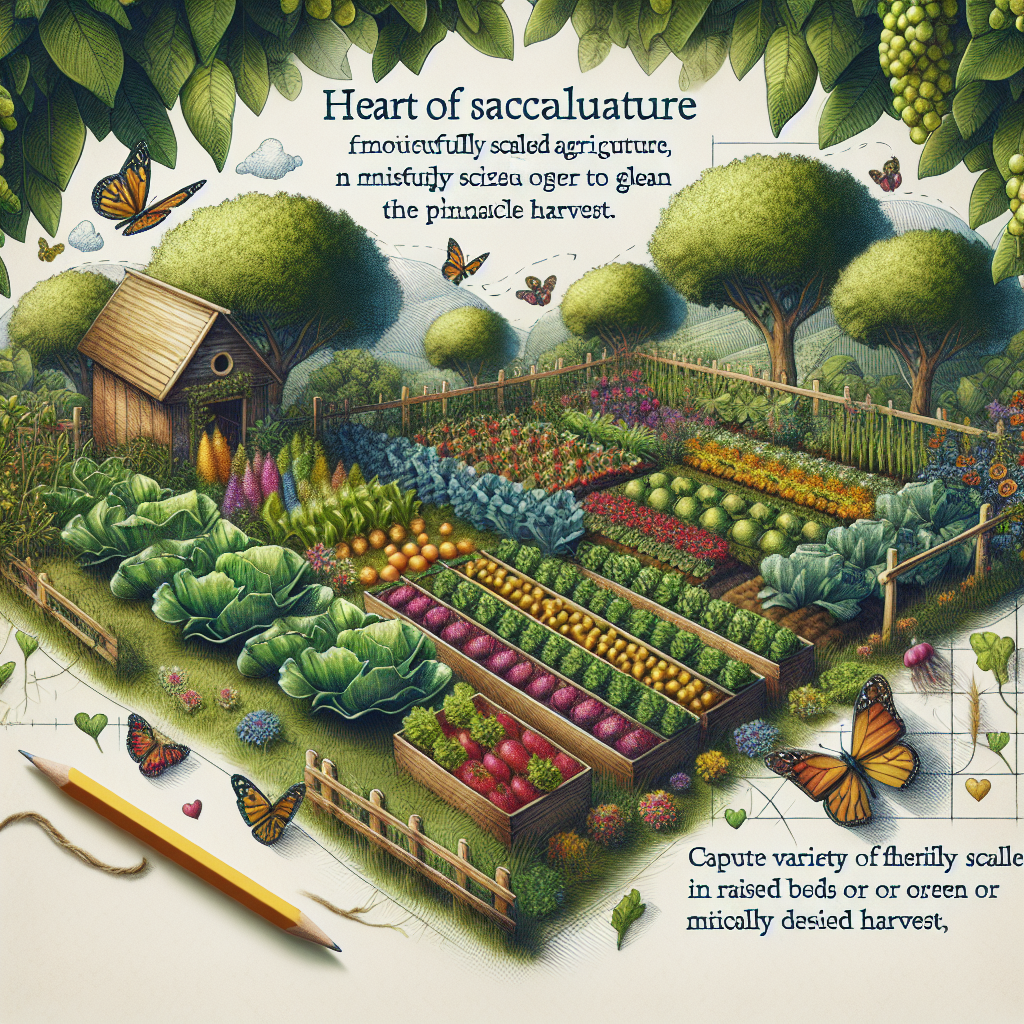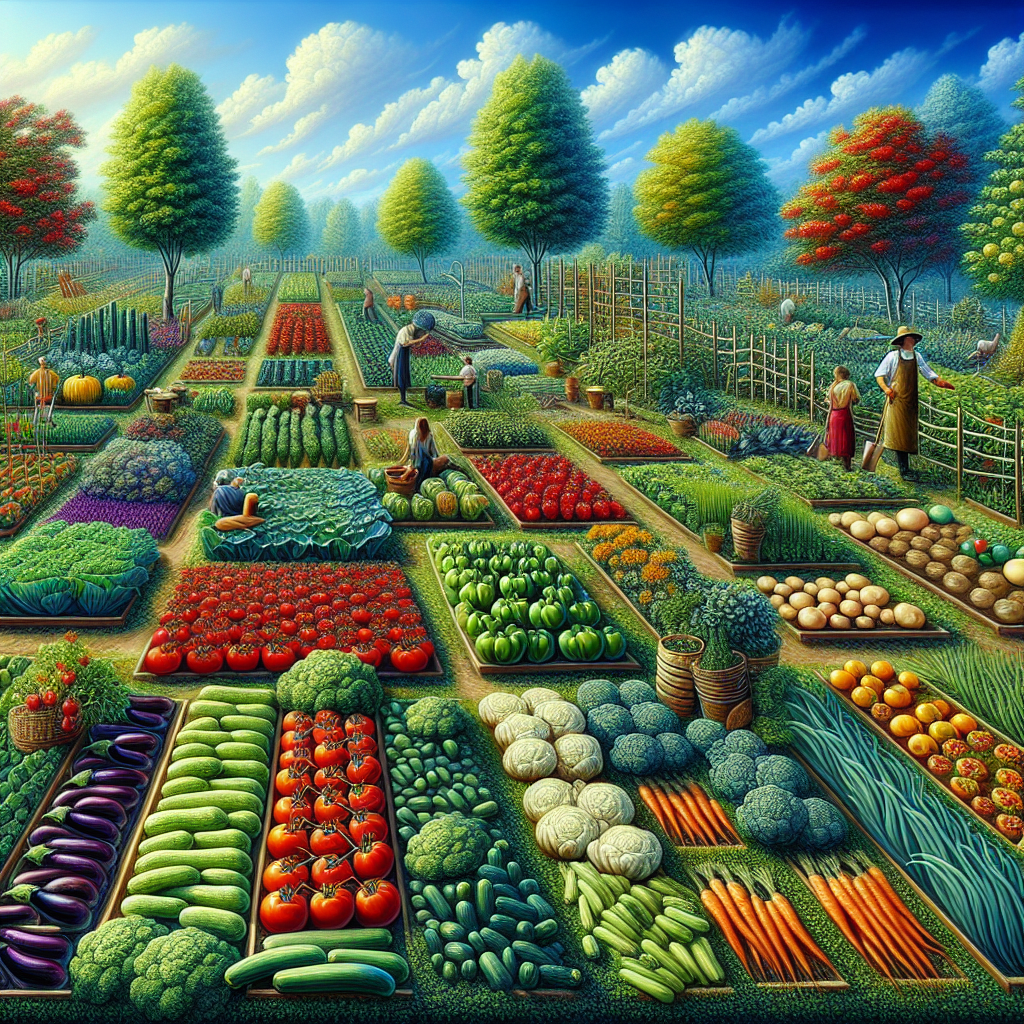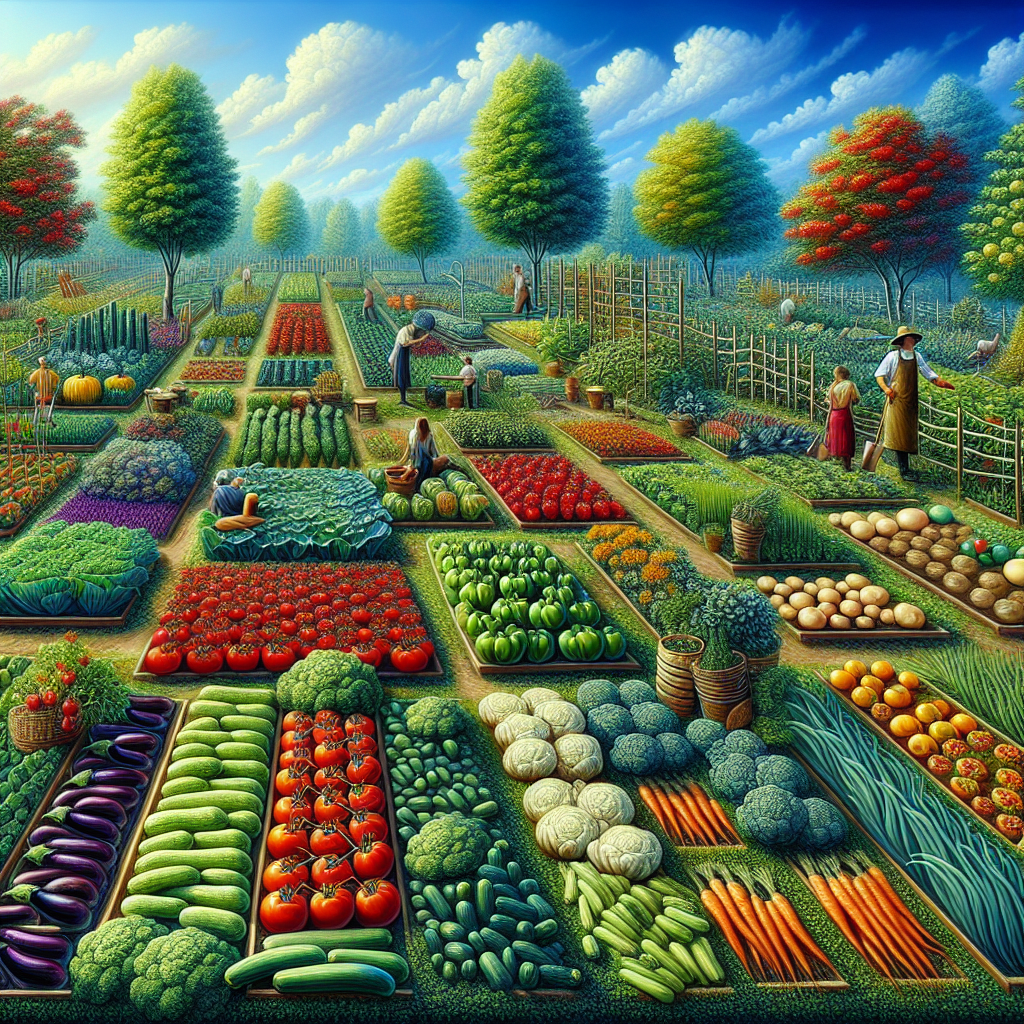Imagine strolling through your backyard, surrounded by vibrant, flourishing plants and harvesting an abundance of fruits and vegetables. Sound like a dream? Well, with proper planning, it can become your reality. In this article, we will guide you through the process of planning your garden layout for maximum yield. By strategically organizing your plants, considering their specific needs, and utilizing space efficiently, you can optimize your garden’s productivity and enjoy a bountiful harvest. So grab your gardening gloves and let’s get started on creating your own little slice of paradise!

Selecting the Right Location
Considering sunlight exposure
When selecting a location for your garden, it is essential to consider the amount of sunlight exposure that area receives. Most plants require at least six hours of direct sunlight each day to thrive and produce a bountiful harvest. Take note of the sun’s movement throughout the day and choose an area with maximum sun exposure. Avoid placing your garden in the shadow of tall buildings or trees that can block the sunlight.
Analyzing soil conditions
Another crucial factor to consider when selecting a location for your garden is the soil conditions. Ideally, you want soil that is fertile, well-draining, and rich in organic matter. Conduct a soil test to determine the pH level and nutrient content. Based on the results, you might need to amend the soil with organic matter, such as compost or aged manure, to create an optimal growing environment for your plants.
Assessing drainage and water availability
In addition to soil conditions, it is vital to assess the drainage and water availability in the chosen location. Proper drainage ensures that excess water does not accumulate around the roots of your plants, which can lead to root rot and other diseases. Additionally, you need to have easy access to a water source for regular watering. Consider whether the chosen location has good natural drainage and proximity to a water supply, such as a hose or rain barrel.
Choosing the Best Garden Layout
Row gardening
Row gardening is one of the most common garden layouts, where plants are arranged in straight rows with defined pathways between them. This layout is especially suitable for larger gardens and crops that require ample space, such as corn or squash. Row gardening allows for efficient space utilization and easy access for weeding, watering, and harvesting. However, this layout may require more maintenance, as weeds tend to flourish between rows.
Square foot gardening
Square foot gardening is a popular layout for smaller spaces or raised beds. In this method, the garden is divided into square-foot sections, and each section is dedicated to specific crops. This layout maximizes space utilization and simplifies planning and planting. It also reduces the need for excessive weeding and maintenance. Square foot gardening is particularly suitable for growing a variety of herbs, salad greens, and compact vegetables.
Vertical gardening
In situations where space is limited, vertical gardening offers a creative solution. By utilizing trellises, stakes, or vertical structures, you can grow plants vertically, saving horizontal space. This layout is beneficial for vining or climbing plants, such as tomatoes, cucumbers, or beans. Vertical gardening maximizes space efficiency, allows better airflow, and makes harvesting easier. However, it requires careful consideration of the weight-bearing capacity of the structure and proper anchoring to prevent collapse.
Calculating Available Space
Measuring the garden area
Before designing your garden beds, it is crucial to measure the available space accurately. Measure the length and width of your garden area, taking into account any obstacles or irregular shapes. This will help you determine the total area available for planting and guide the layout design process.
Determining the growing space
Once you have measured the garden area, it is essential to consider how much space each plant requires to grow optimally. Different crops have varying space requirements based on their size and growth habit. Some plants, like lettuce or radishes, can be grown in closer proximity, while others, like tomatoes or peppers, need more space. Refer to seed packets or gardening resources to determine the recommended spacing for each crop.
Considering pathways and access points
In addition to accommodating the growing space of your plants, it is crucial to plan for pathways and access points within your garden. Well-designed pathways provide easy navigation and allow you to tend to your plants without causing damage. Consider the width of your pathways and ensure they are wide enough to comfortably walk and maneuver garden tools. Additionally, plan for access points that allow you to enter and exit the garden easily, especially if you are carrying tools or harvest baskets.
Designing Garden Beds
Determining bed size and shape
When designing your garden beds, you need to determine the appropriate size and shape based on the available space and your gardening goals. Raised beds are a popular option as they provide better drainage, soil control, and easier access for gardening activities. The size of your beds will depend on factors such as the length of your arms for comfortable reach, the amount of sunlight each area receives, and the type of plants you intend to grow. Rectangular or square-shaped beds are common, but you can also incorporate circular or curved shapes for a visually appealing design.
Optimizing soil depth and quality
To ensure optimal plant growth, it is essential to consider the depth and quality of the soil in your garden beds. Most vegetables and herbs require a soil depth of at least 6-12 inches for their roots to spread and access necessary nutrients. If your soil is shallow or of poor quality, consider adding additional soil, compost, or aged manure to improve its depth and fertility. Incorporating organic matter will also enhance soil structure and water retention capabilities, leading to healthier plants and higher yields.
Planning for companion planting
Companion planting involves growing certain plants together to benefit from their mutually beneficial relationships. Some plants can act as natural pest deterrents, enhance the flavor or growth of neighboring plants, or improve soil conditions. When designing your garden beds, consider incorporating companion planting strategies to maximize yield and promote overall plant health. Research companion planting combinations that work well for the crops you intend to grow, and plan your bed layout accordingly.

Organizing Crop Rotation
Understanding the importance of crop rotation
Crop rotation is a valuable practice that involves changing the location of crops in subsequent growing seasons. It helps prevent the buildup of pests, diseases, and nutrient imbalances in the soil. By rotating crops, you can disrupt pest life cycles, reduce the risk of disease transmission, and maintain soil fertility. Understanding the specific needs and potential problems of each crop will enable you to plan an effective crop rotation schedule for your garden.
Implementing a crop rotation plan
To implement a crop rotation plan, divide your garden into sections and designate a specific plant family for each section. Rotate crops within these sections, ensuring that plants from the same family are not grown in the same area for consecutive seasons. Ideally, it is best to rotate crops every two to three years. Remember to consider any specific requirements or restrictions of each crop when determining the rotation schedule.
Utilizing cover crops
Cover crops, also known as green manure, are plants specifically grown to benefit the soil and improve its condition during fallow periods or between growing seasons. Cover crops help suppress weeds, prevent erosion, add organic matter to the soil, and enhance its fertility. Some common cover crops include clover, rye, buckwheat, and vetch. By incorporating cover crops into your rotation plan, you can maintain soil health and maximize the productivity of your garden.
Considering Plant Spacing
Determining plant spacing requirements
Each plant has specific spacing requirements based on its growth habit, size, and nutrient requirements. Adequate spacing between plants ensures they have enough room to grow, access sunlight, and receive proper airflow, reducing the risk of diseases. Refer to planting guides, gardening resources, or seed packets to determine the recommended spacing for each crop. Consider the fully mature size of the plant and the desired yield when determining plant spacing.
Using intercropping or companion planting
Intercropping involves growing different crops interspersed within the same garden bed. It maximizes space utilization by planting complementary crops that can coexist and thrive together. For example, planting lettuce or radishes between rows of slower-growing crops like tomatoes or peppers effectively utilizes the available space. Companion planting, as mentioned earlier, can also help optimize plant spacing by choosing plants that grow well together and complement each other’s growth patterns.
Including pathways for easy access
As mentioned earlier, pathways play a vital role in providing access to your plants for maintenance and harvesting. However, they also help ensure adequate plant spacing by creating physical barriers between rows or beds, preventing overcrowding. Consider the width of your pathways when determining plant spacing, ensuring that they are wide enough to provide adequate space for mature plants and safe maneuverability.
Utilizing Vertical Space
Maximizing space with trellises and stakes
Vertical gardening provides an excellent opportunity to maximize space utilization by training plants to grow upwards using trellises, stakes, or other vertical supports. Installing trellises or stakes allows vining or climbing plants like cucumbers, beans, or tomatoes to grow vertically, saving valuable horizontal space. This method not only increases the growing area but also improves air circulation around the plants, reducing the risk of diseases.
Choosing vining or climbing varieties
To effectively utilize vertical space, it is essential to choose vining or climbing varieties of plants. These varieties have a natural tendency to grow upwards and can be trained to climb along trellises or stakes. Look for plant varieties labeled as “indeterminate” or “vining” to ensure they have the necessary characteristics for vertical growth. By selecting appropriate varieties, you can make the most of limited space and enjoy a larger harvest.
Managing vertical crops effectively
Vertical gardening requires proper management to ensure the plants are adequately supported and trained to grow in the desired direction. Regularly check the trellises or stakes to ensure they are secure and can bear the weight of the plants. As the plants grow, gently guide the stems towards the support structure and secure them with ties or clips if necessary. Prune and train the plants as needed to maintain a neat and organized vertical garden.
Creating Microclimates
Identifying microclimate factors
Microclimates are localized climate conditions within a larger region, influenced by factors such as sunlight, wind, temperature, and soil moisture. Identifying the microclimate factors in your garden can help you create optimal growing conditions for different plants. Some areas of your garden may receive more sunlight, while others might be exposed to stronger winds or cooler temperatures. By understanding these microclimates, you can strategically place plants according to their specific environmental requirements.
Using shelters or windbreaks
If your garden is located in an area prone to strong winds, using shelters or windbreaks can help create a more favorable growing environment. Planting tall shrubs, trees, or constructing physical barriers like fences or walls can shield your plants from the wind and reduce the risk of damage or stress. Additionally, shelters or windbreaks can provide shade during hot summer months, helping to regulate the temperature in the garden.
Implementing protective structures
In regions with extreme climates or unpredictable weather conditions, implementing protective structures can help mitigate the impact on your plants. Options such as greenhouses, cold frames, or row covers can extend the growing season, create a more controlled environment, and protect plants from frost, hail, or excessive heat. Consider your climate and the specific needs of the crops you want to grow when deciding whether to incorporate protective structures into your garden design.
Choosing the Right Crop Varieties
Understanding climate and zone requirements
Different crops have specific climate and hardiness zone requirements for optimal growth and productivity. Familiarize yourself with the climatic conditions and hardiness zones in your region to choose appropriate plant varieties. Some crops are more heat-tolerant, while others thrive in cooler temperatures. Additionally, pay attention to the length of your growing season as certain varieties require longer or shorter periods to mature. By selecting crop varieties suited to your local climate, you increase the chances of a successful and high-yielding garden.
Selecting disease-resistant varieties
Plant diseases can significantly impact the health and productivity of your garden. To mitigate the risk of disease, it is advisable to choose disease-resistant varieties whenever possible. Disease-resistant varieties are bred to be less susceptible to specific diseases, reducing the need for chemical treatments or interventions. Conduct research or consult with local nurseries to identify disease-resistant varieties that are well-suited to your garden’s conditions and the crops you wish to grow.
Considering yield potential
When choosing crop varieties, consider the yield potential of each plant. Some plants naturally produce higher yields, making them more suitable for gardens focused on achieving maximum productivity. However, it’s essential to strike a balance between yield potential and the available space in your garden. Growing a few high-yield plants can be more efficient and rewarding than overcrowding your garden with too many low-yield varieties. Research the average yield potential for each crop and select varieties that align with your goals and garden size.
Accounting for Seasonality
Planning for year-round harvests
To maximize the yield from your garden, it is advantageous to plan for year-round harvests. By utilizing succession planting and selecting crops with varying maturity dates, you can ensure a continuous supply of fresh produce throughout the growing season. Succession planting involves sowing seeds or planting seedlings in stages, allowing for a constant rotation of crops as one is harvested, providing space for new plantings. Consider the length of your growing season and the typical harvest time for different crops to create a planting schedule that accounts for year-round productivity.
Strategizing succession planting
When implementing succession planting, strategic planning is crucial. Start by determining the average maturity date for each crop variety you wish to grow. Then, calculate the time needed for harvesting and replanting. Based on this information, you can determine the ideal time to sow seeds or transplant seedlings at regular intervals. This systematic approach allows for a continuous supply of fresh crops from early spring to late fall.
Implementing season extension techniques
In regions with shorter growing seasons, implementing season extension techniques can help prolong the productivity of your garden. Options such as using row covers, cloches, or cold frames can protect plants from early frost or extend the growing season in late fall. Additionally, you can explore using heat sources, like heat lamps or heated propagators, to start seeds indoors earlier and give them a head start. By adopting season extension techniques, you can enjoy a more extended harvest period and increase overall yield.
Planning your garden layout for maximum yield requires thoughtful consideration of various factors. By selecting the right location, choosing an appropriate garden layout, calculating available space, designing garden beds, organizing crop rotation, considering plant spacing, utilizing vertical space, creating microclimates, choosing the right crop varieties, and accounting for seasonality, you can create an efficient and productive garden. Take the time to research, plan, and implement these strategies, and you’ll be well on your way to a fruitful and rewarding gardening experience.

